Woodpeckers are birds that live in the wild. They are a part of a family called Picidae. Except for Australia, New Guinea, New Zealand, Polar Regions, and Madagascar, most of the members of this family are found worldwide. Among them, Woodpeckers in Indiana are the most popular woodpeckers in the world.
First, we should know about the appearance of the woodpeckers. As all aware, woodpeckers have pointed and strong beaks. They used it for digging nest holes and insects from trees. The unique thing is they used it for “Drumming” (Usually woodpeckers don’t have actual song and they perform rhythmic tapping from their sharp noises from their beaks. That is called “Drumming”). Both genders have this king of woodpeckers drum. When it’s come to their body, the weight of the Woodpecker (adult woodpeckers) is approximately 0.74 – 12.36 ounces. And its length is around 6 ½ – 16 ½ inches. And they have short legs with two backward pointed toes, not only that their legs have two sharp-clawed toes as well as these toes of the woodpeckers are along with their stiff tail feathers. It helps them to wood siding and clings to trees. Woodpeckers have primary 3 colors, and white, red and black are those colors. These birds usually lay 3-6 eggs at a time. Not only that, their period of incubation is approximately 11 – 12 days. These details change on the species of the Woodpecker.
Now we should check about the Woodpecker in Indiana. As mentioned before, there are so many woodpeckers around the world. Among them, there are 7 notable species of Woodpecker in Indiana. Those 7 Indiana woodpeckers are as follows.
Woodpecker in Indiana species – Number 01: Hairy Woodpecker
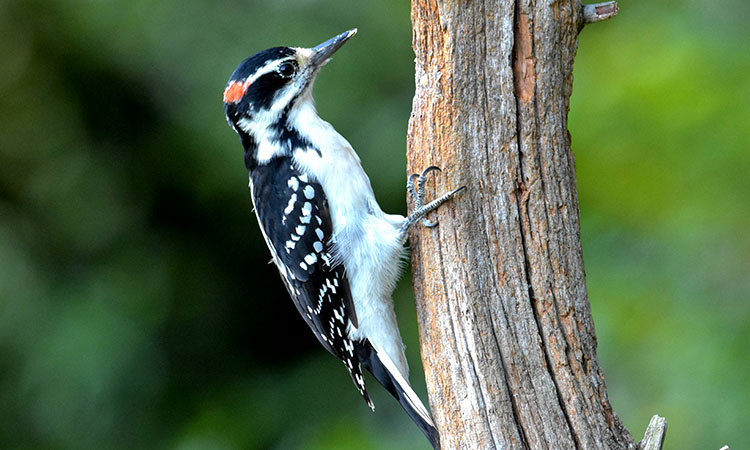
This Hairy Woodpecker is a year-round resident of Indiana. Not only that, they are the ones who are the residents’ majority of the US. Hairy woodpeckers have the medium-sized body. The color of their body is unique, and it’s a bit orangey, and there are red patches on the top of their feathers in their head. Very commonly, this species is seen at birds’ feeders. These birds have dark wings and backs as well. The Hairy Woodpecker is similar to the Downy Woodpecker. And also, they are like a little brother to the Hairy Woodpecker. These kinds of woodpeckers eat the same things as Downy’s. If someone sees Downy and Hairy woodpeckers together, no one can understand the two verities because their appearance is similar.
When talking about their living style, they love to nest in woodland areas. They have an unusual behavior when it’s come to fights. They raise their wings behind their backs and make a sharp cry to warn others that conflict may ensue. That will happen because males have an aggressive display. They lay 3 – 6 eggs per year.
Here is some more information about Hairy Woodpecker.
Scientific name : Leuconotopicus Villosus
Life expectancy : 15 years
Food : Tree sap and Wood-boring insects
Weight : 1.4 – 3.4 Ounces
Length : 7.1 – 10.2 Inches
Wingspan : 13 – 16.1 Inches
Woodpecker in Indiana species – Number 02: Downy Woodpecker
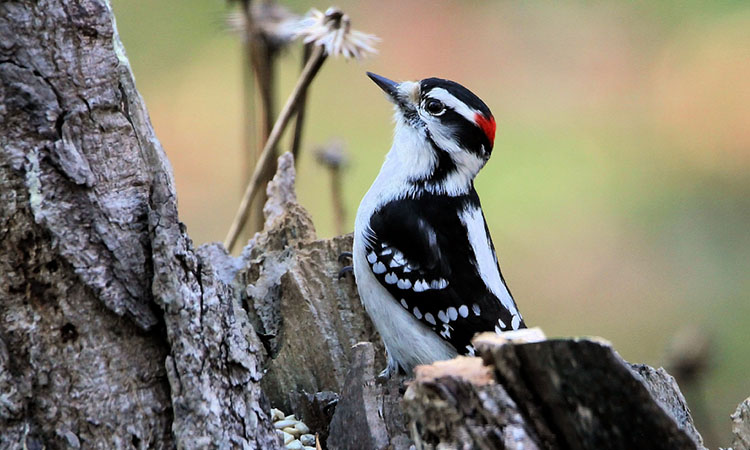
This Woodpecker is the species that most diminutive Woodpecker in Indiana and North America. Downy woodpeckers can be seen in all the regions of Indiana. These woodpeckers don’t migrate, and they are seen very common in the wintertime. The Downy Woodpecker has a similar color as the Hairy Woodpecker. They have dark wings and backs, and also the back of their head has a small red spot. They like to build their nests near water areas (Rivers/streams close to the forest). And also, they want to nest in dead trees/branches on trees.
Here is some more information about Downy Woodpecker.
Scientific name : Picoides Pubescens
Life expectancy : 12 years
Food : Non-insect arthropods
Weight : 0.75 – 1 Ounces
Length : 5.5 – 6.7 Inches
Wingspan : 3.27 – 11.8 Inches
Woodpecker in Indiana specie – Number 03: Red-Bellied Woodpecker
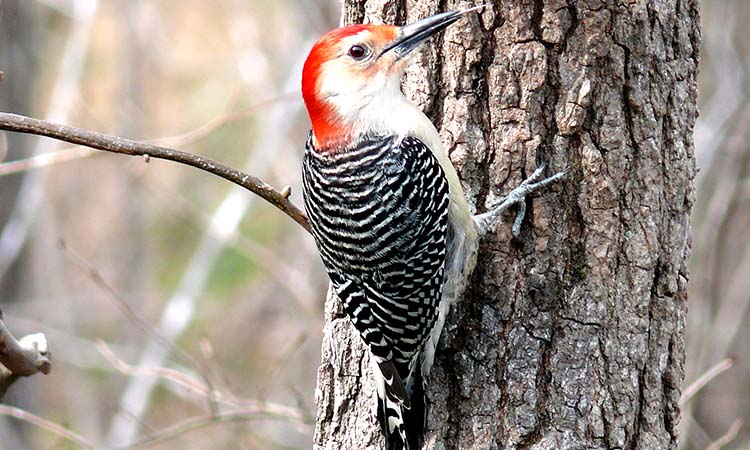
Red-bellied Woodpecker is larger than the Downy Woodpecker. And also, they have a similar size as Hairy woodpeckers. They can be identified from the Red Mohawk down their neck. Their back is filled with white and black feathers. They have brighter feathers in red color on their heads. As per their name, they have a red belly. That is the reason they called these woodpeckers as Red-Bellied woodpeckers. These woodpeckers build their nests in both dense and subtropical forest areas and either form permanent nests there. And year after year, they make their nests in the same tree, but they often use another hole and lay about 2-6 eggs.
Here is some more information about Red-Bellied Woodpecker.
Scientific name : Melanerpes carolinus
Life expectancy : 12 years
Food : Insect
Weight : 2.65 – 3.2 Ounces
Length : 9.4 Inches
Wingspan : 13 – 18 Inches
Woodpecker in Indiana specie – Number 04: Yellow-Bellied Sapsucker
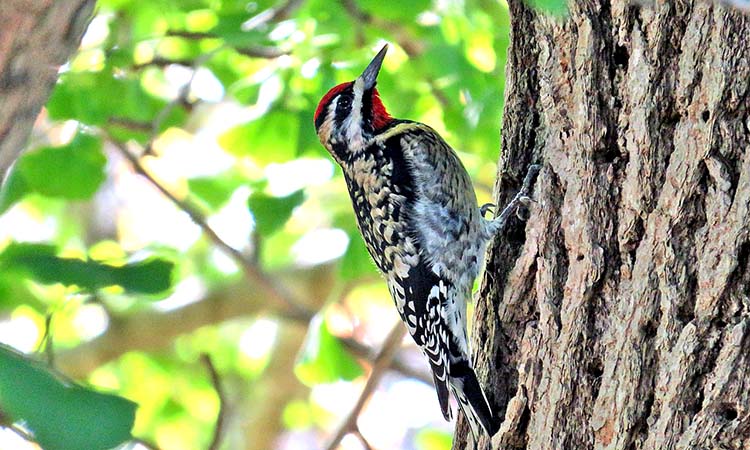
As per its name, this Woodpecker has a Pale Yellow belly. Not only that, they can identify from their unusual red crown. Yellow-Bellied Sapsucker is also a woodpecker that lives in Indiana, and they have a small body compared to other woodpeckers. These woodpeckers drill holes, especially in maple trees. These species have different aggressive displays, and they only show that to members of the same sex. They have a light black body (under the body), red feathers (above and below beaks), and black chests. Yellow-Bellied Sapsucker migrates to the outside from Indiana to Northern states (Michigan) Canada in their breeding period.
Here is more information about Yellow-Bellied Sapsucker.
Scientific name : Sphyrapicus varius
Life expectancy : 07 years
Food : Insects, Fruits, and Tree sap
Weight : 1.5 – 1.9 Ounces
Length : 7.1 – 8.7 Inches
Wingspan : 13.4 – 16 Inches
Woodpecker in Indiana specie – Number 05: Red-Headed Woodpecker
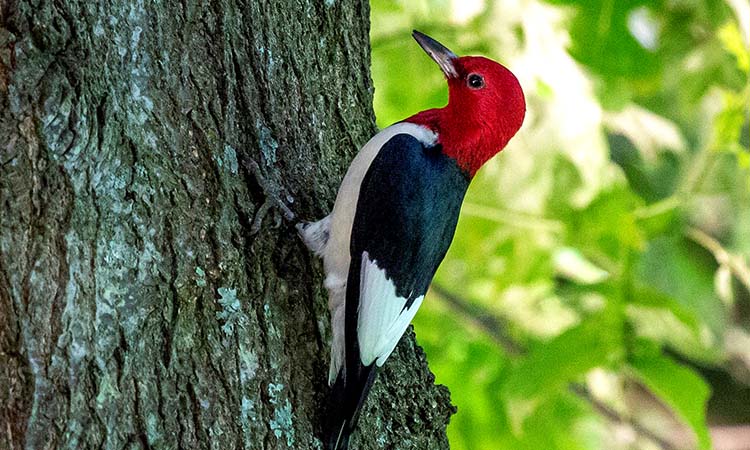
Red-Headed Woodpecker is a medium-sized woodpecker. As for the name, Red-Headed Woodpecker covered its head with bright red feathers. The rest of the parts of the body are covered in both grey and white feathers. This kind has a different feeding style, and they like to store live insects, and later, they catch them from the tree bark.
Here is some more information about the Red-Headed Woodpecker.
Scientific name : Melanerpes erythrocephalus
Life expectancy : 09 years
Food : Beetles, Seeds, and Berries.
Weight : 3.9 – 5.6 Ounces
Length : 11 – 12.2 Inches
Wingspan : 16.5 – 20.1 Inches
Woodpecker in Indiana species – Number 06: Northern Flicker
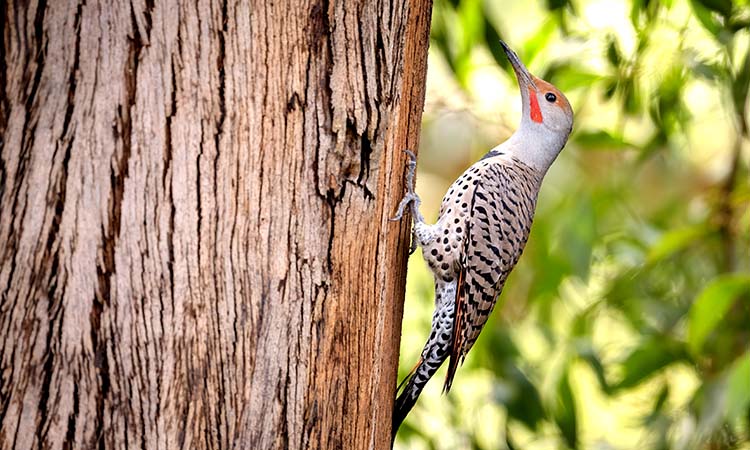
Northern Flickers are one of the notable woodpeckers in Indiana, and these birds are relatively large. But they are smaller than the Pileated Woodpecker and more prominent than the Hairy Woodpecker. They have a red back neck, underbellies are spotted, bibs are black, and tails are yellow with red patches and red patches of the face. When comparing to others birds, these birds are very colorful.
Here is some more information about Northern Flicker.
Scientific name : Colaptes auratus
Life expectancy : 09 years
Food : Nuts, Fruits, Seeds, and Insects.
Weight : 2.5 – 6 Ounces
Length : 7.5 – 9.1 Inches
Wingspan : 21.3 Inches
Woodpecker in Indiana species – Number 07: Pileated Woodpecker

Pileated Woodpeckers are built their cavities in trunks and dead trees. The shape is rectangular, and this habit is not typical for the woodpecker family. This Woodpecker is the largest Woodpecker in North America as well as Indiana. They have a prominent display of red feathers on their heads. Their necks are covered in white, and the rest of the body is covered with dark feathers.
Here is some more information about Pileated Woodpecker.
Scientific name : Dryocopus pileatus
Life expectancy : 13 years
Food : Nuts, Fruits, and Insects.
Weight : 8.8 – 14.1 Ounces
Length : 15.8 – 19.3 Inches
Wingspan : 26 – 30 Inches
If you would like to read more articles like this – “Albino Owl” is a gorgeous bird in the owl world that ladies might get jealous of

Hi its Ishu
I am a freelancer and my working ground is based on writing articles on conversational and trending titles. I can do anything that is related to my job. Also, I have been successfully handling my job as an SEO. I have a Bachelor of Management (Hons) in Marketing from Horizon Campus.
Let”s win together. ADIOS


